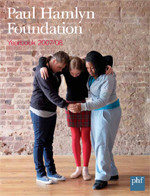Financial Review
Endowment fund and investment portfolio
Investment in private equity and hedge funds
Increasing proportion of overseas equity investments
The Endowment fund represents the original and subsequent gifts by Paul Hamlyn, both in his lifetime and under the terms of his will, together with net gains arising from the related investment assets. The trustees have discretion to make disbursements from the Endowment fund in circumstances which they consider appropriate; it is not currently their intention to do so. Investment returns from the endowment investment portfolio are used to finance grant-making and other work.
The Endowment fund benefited from the addition of a further £0.2 million from the winding up of Paul Hamlyn’s estate, but it incurred net capital losses of £36.9 million as global capital markets suffered declines and retreated from the high levels reached during 2007. The total size of the fund fell to £494.1 million at 31 March 2008 from£530.8 million at the start of the year.
The Foundation has wide investment powers which are specified in its Memorandum of Association. All trustees are involved in setting investment policy, but authority to decide strategy is delegated to the Finance and Investment Committee. This committee, with input from senior staff and consultants; sets asset allocation; it then engages specialist professional managers. Each manager is given a specific mandate. Most of these are discretionary but the Foundation’s property manager acts on an advisory basis. In addition this year investments were made in a number of hedge funds.
The Foundation’s investment policy is to:
- maintain in the long run the real purchasing power of the Endowment fund.
- invest in a diverse range of assets which are most likely to give good total returns in the long term in order to maximise the total real value of the amounts available for grant-making and other work.
- manage volatility as far as possible, while accepting that a degree of volatility is concomitant with seeking high returns.
In the past two years we have increased the diversity of the assets held, particularly by investing in alternative assets. This is likely to reduce dividend and interest income at least in the short term but is aimed at increasing total returns on a long term basis.
During the year significant investment management developments included:
- a new global equity manager was appointed, replacing a UK only manager.
- investments were made in five long-short equity hedge funds.
- investments decisions on five private-equity funds, a combination of venture and opportunistic/buyout firms.
The main asset allocation changes to the Endowment fund during the year were:
- reducing publicly quoted equities to 56% from 69%; this change includes a tactical reduction of 8% (£40 million) reflecting concerns about downside risks in equity markets.
- increasing the overseas proportion of equity investment to increase diversification and widen the opportunity set available to managers. The proportion of UK: Overseas equities was moved to 35:65 from 59:41.
- an initial move of 4% into long/short equity hedge funds.
The Foundation’s investment portfolio fell by 3.3% for the year, mainly reflecting movements in equity markets. The Foundation has been fortunate to engage Dr Paul Woolley as a member of the Finance and Investment Committee. Dr Woolley’s distinguished career includes academic posts, work at the World Bank and senior investment management roles.
Unrestricted fund
Single unrestricted fund created
Investment income rose to £20.3 million
The Foundation’s unrestricted funds are used to finance the Foundation’s tangible fixed assets/working capital, and to provide a short-term buffer for grant-making and other costs. This year, having regard to the ongoing returns which can be reasonably expected from the Foundation’s large and diversified investment portfolio, the trustees decided that maintaining a separate designated fund (to “earmark” funds for major special initiatives) is no longer appropriate. All unused designations have been reversed, giving a single unrestricted fund. The trustees intend that the unrestricted fund should be approximately six months of grant making expenditure. This fund is currently rather higher than this; it will be reduced in the next few years as a result of increased grant making expenditure, in particular by the implementation of the new special initiatives, and expected future short term reductions in income.
Income and expenditure
Investment income increased to £20.3 million in 2008 from £17.9 million.
Investment management charges grew to £2.2 million from £1.8 million; the change was partly due to increased investment in overseas equities where charges are generally higher. Additionally, we broadened the mandate of our advisers Cambridge Associates in order to support the development and management of the Foundation’s alternative assets programme.
Grant awards (included within grant-making) were lower in 2008 at £14.4 million compared to £19.0 million in 2007, which included £10.0 million for the Royal Opera House’s Paul Hamlyn Education Fund. Excluding funding for the Helen Hamlyn Trust, 25% of 2008 awards were made on the special initiatives and 75% under the open grants programmes. This is about the same proportion as in 2007. Trustees intend to increase significantly the proportion of expenditure on special initiatives.
Support costs (included within grant-making) and Governance increased to £1.9 million in 2008 from £1.5 million. Cost inflation played a part, but most of the change resulted from additional staff to increase capacity and expertise, reflecting a wider range of grant-making. Unrestricted funds not financing fixed and working capital are held in the form of cash or near-cash securities. Financial risks
The Foundation’s principal material financial risks, including foreign exchange exposures, relate to its investment portfolio; these are unavoidable when strong returns are sought. The overall portfolio risk is managed by diversification across asset classes and markets, and the selection of competent asset managers each of whom is responsible for controlling the various risks of the holdings it controls. The Foundation is a long-term investor and believes it can accept a degree of short term volatility.
